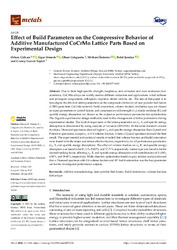Effect of build parameters on the compressive behavior of additive manufactured CoCrMo lattice parts based on experimental design
| dc.contributor.author | Gülcan, O. | |
| dc.contributor.author | Simsek, U. | |
| dc.contributor.author | Çokgünlü, Okan | |
| dc.contributor.author | Özdemir, Mirhan | |
| dc.contributor.author | Şendur, Polat | |
| dc.contributor.author | Yapıcı, Güney Güven | |
| dc.date.accessioned | 2023-06-21T11:17:22Z | |
| dc.date.available | 2023-06-21T11:17:22Z | |
| dc.date.issued | 2022-07 | |
| dc.identifier.issn | 2075-4701 | en_US |
| dc.identifier.uri | http://hdl.handle.net/10679/8449 | |
| dc.identifier.uri | https://www.mdpi.com/2075-4701/12/7/1104 | |
| dc.description.abstract | Due to their high specific strength, toughness, and corrosion and wear resistance characteristics, CoCrMo alloys are widely used in different industries and applications: wind turbines and jet-engine components, orthopedic implants, dental crowns, etc. The aim of this paper is to investigate the effect of lattice parameters on the compressive behavior of laser powder bed fusion (LPBF) parts from CoCrMo material. Build orientation, volume fraction, and lattice type are chosen as input parameters or control factors, and compressive yield strength (σy), elastic modulus (E), and specific energy absorption are chosen as the output or performance parameters for optimization. The Taguchi experimental design method is used in the arrangement of lattice parameters during experimental studies. The level of importance of the lattice parameters on σy, E, and specific energy absorption is determined by using analysis of variance (ANOVA). At the same material volume fractions, Diamond specimens showed higher σy and specific energy absorption than Gyroid and Primitive specimens, except σy at 0.4 volume fraction, where a Gyroid specimen showed the best result. The experimental and statistical results revealed that volume fraction and build orientation were found to be the major and minor effective factors, respectively, for all performance parameters (σy, E, and specific energy absorption). The effect of volume fraction on σy, E, and specific energy absorption was found to be 85.11%, 91.83%, and 57.71%, respectively. Lattice type was found to be the second-ranking factor, affecting σy, E, and specific energy absorption with contributions of 11.04%, 6.98%, and 39.40%, respectively. Multi objective optimization based on grey relation analysis showed that a Diamond specimen with 0.4 volume fraction and 45◦ build orientation was the best parameter set for the investigated performance outputs. | en_US |
| dc.description.sponsorship | TÜBİTAK | |
| dc.language.iso | eng | en_US |
| dc.publisher | MDPI | en_US |
| dc.relation | info:turkey/grantAgreement/TUBITAK/5158001 | |
| dc.relation.ispartof | Metals | |
| dc.rights | openAccess | |
| dc.rights.uri | https://creativecommons.org/licenses/by/4.0/ | |
| dc.title | Effect of build parameters on the compressive behavior of additive manufactured CoCrMo lattice parts based on experimental design | en_US |
| dc.type | Article | en_US |
| dc.description.version | Publisher version | en_US |
| dc.peerreviewed | yes | en_US |
| dc.publicationstatus | Published | en_US |
| dc.contributor.department | Özyeğin University | |
| dc.contributor.authorID | (ORCID 0000-0003-2212-7419 & YÖK ID 274138) Şendur, Polat | |
| dc.contributor.authorID | (ORCID 0000-0001-5692-4809 & YÖK ID 163236) Yapıcı, Güven | |
| dc.contributor.ozuauthor | Şendur, Polat | |
| dc.contributor.ozuauthor | Yapıcı, Güney Güven | |
| dc.identifier.volume | 12 | en_US |
| dc.identifier.issue | 7 | en_US |
| dc.identifier.wos | WOS:000832153300001 | |
| dc.identifier.doi | 10.3390/met12071104 | en_US |
| dc.subject.keywords | Additive manufacturing | en_US |
| dc.subject.keywords | Build orientation | en_US |
| dc.subject.keywords | Laser powder bed fusion | en_US |
| dc.subject.keywords | Lattice type | en_US |
| dc.subject.keywords | Volume fraction | en_US |
| dc.identifier.scopus | SCOPUS:2-s2.0-85132917451 | |
| dc.contributor.ozugradstudent | Çokgünlü, Okan | |
| dc.contributor.ozugradstudent | Özdemir, Mirhan | |
| dc.relation.publicationcategory | Article - International Refereed Journal - Institutional Academic Staff and Graduate Student |
Files in this item
This item appears in the following Collection(s)
Share this page




